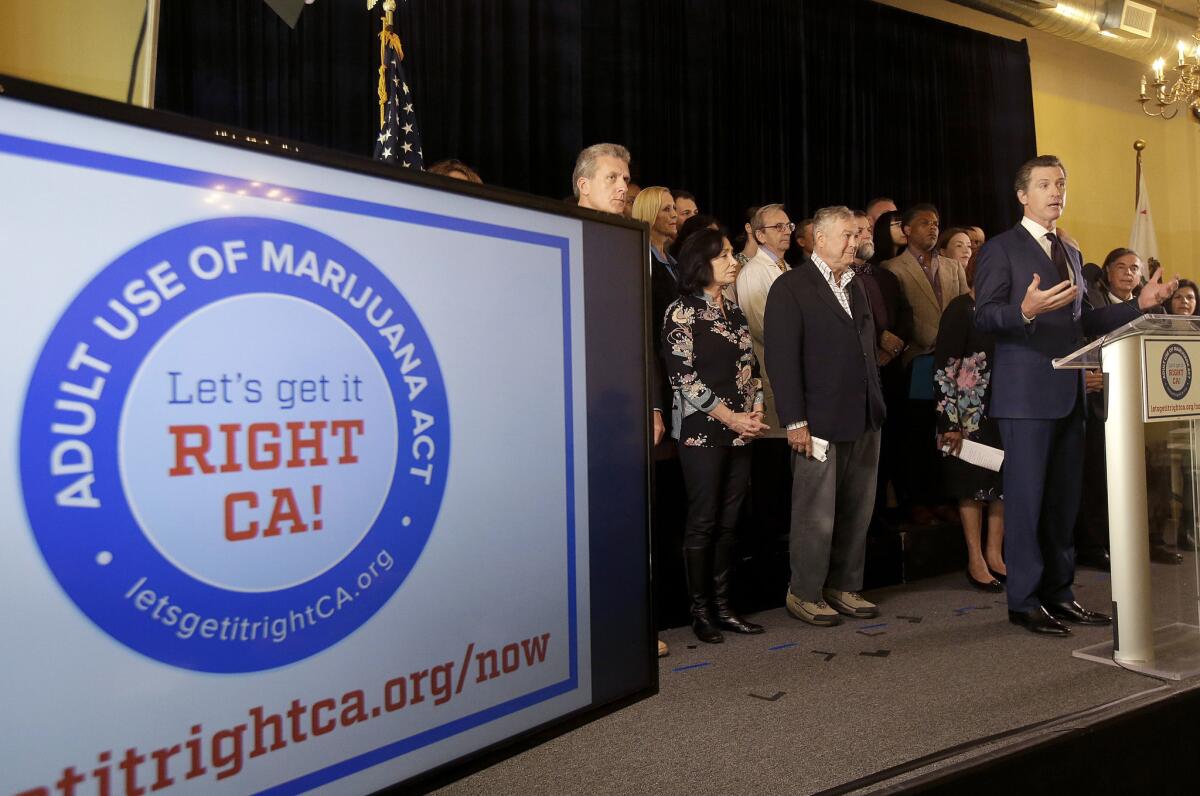Op-Ed: Why this time will be different for marijuana legalization

- Share via
Californians first threatened to legalize recreational marijuana by ballot initiative in 1972. It failed 66% to 33%. We tried again in 2010. It was voted down 53% to 46%.
Now we’re back at it. This time, though Proposition 64 looks like a sure thing. Polls show support for legalization in general at 55%, and 60% among likely voters. What’s so different this time around?
For the record:
5:56 p.m. May 20, 2025Marijuana — An Aug. 20 op-ed incorrectly stated that Proposition 64 would delay vertical integration (farm-to-pot-shop) of recreational marijuana until 2023. There is no delay for small- and mid-sized growers to apply for licenses as manufacturers, distributors, or retailers. Only large-scale growers must wait until 2023 to apply, at which point they will still face limitations on integration.
Yes, demographics and attitudes have shifted here, like everywhere. But you also have to understand what went wrong back in 2010. At the time, California — the state that pioneered pot for the people — seemed poised to become the first state to legalize recreational marijuana, but the cause was unexpectedly hurt by the state’s convoluted history with medical marijuana.
When medical marijuana was legalized here by ballot initiative in 1996, it was groundbreaking — but the law itself left many unanswered questions: How would pot be sold to patients? How would the state regulate those sales? State legislation, SB 420, tried to sort that out, but it left sellers even more confused. Were dispensaries allowed to profit? The guy who wrote the law, late state Sen. John Vasconcellos, said sure. Others, including former L.A. City Attorney Carmen Trutanich, said medical weed had to be a nonprofit enterprise. The rules and enforcement issues weren’t fully worked out until last year, when Gov. Jerry Brown signed the Medical Marijuana Regulation and Safety Act.
Meanwhile, cities including Los Angeles struggled to keep a lid on hundreds of new dispensaries opening during the period of regulatory chaos. By 2010, years of problems policing and monitoring medical sales had taken a toll on the credibility of pro-pot activists.
It became clear that if pot legalization was going to attract majority support in California, any ballot initiative was going to have to be about more than the freedom to get high. It was going to have to delve into the details about how this was all going to work. And proponents were going to have to step up their political game.
They did.
Six years ago, Proposition 19 was a one-man-band of an initiative run by Oakland cannabis entrepreneur Richard Lee. Today’s effort, Proposition 64, by contrast, is so professional it scares some old-school marijuana activists. Even some pro-marijuana groups are uncomfortable with how the measure is written to appeal to law-and-order voters.
For instance, Proposition 64 would have the state establish a Bureau of Medical Marijuana Regulation in the Department of Consumer Affairs to police the industry. Taxes of 15% at the cash register would pay for that agency and benefit police. The law also allows cities like Los Angeles to continue to limit or ban dispensaries, recreational or not.
“It’s 60% legalization,” Ellen Komp, deputy director of California NORML, has said.
The authors of Proposition 64 have thought through the details this time.
But that might be just the right amount for California voters.
The Yes on 64 campaign has been endorsed by Lt. Gov. Gavin Newsom and the California NAACP. It is so sophisticated that it has a Latino outreach arm. Amid threats last year that rival marijuana groups might put competing measures on the ballot in November, Yes on 64 cleared the field and got most pro-pot soldiers to fall in line. It has raised nearly $8.5 million, including $2.5 million from former Facebook President Sean Parker. Voters may, for the first time, see pro-legalization campaign advertisements.
The opposition, meanwhile, has raised only $163,370, and its campaign is relying on old scare-tactic arguments: Legalization will expose more teens to marijuana, bring pot stores to every corner, or allow pot ads on TV.
The No on 64 crowd also asserts the initiative is a scheme to allow Parker and his ilk to create Big Tobacco-style pot companies. It’s true the measure would allow vertically integrated enterprises — from the farm to the pot shop — but not before 2023. And large producers would not be allowed to merge, according to the Drug Policy Alliance’s reading of the ballot language. The authors of Proposition 64 have thought through the details this time.
It wasn’t just California’s pot activists that learned from the loss in 2010. Stephen Gutwillig, then the state director of Drug Policy Alliance, said in 2010 that Proposition 19 “moved marijuana legalization into the mainstream of American politics.”
Indeed, it set the stage for Colorado to legalize recreational weed in 2012. Oregon, Washington and Alaska followed. That moved the spotlight off California for a few years, but also gave voters here a picture of what orderly legalization could look like.
Once Proposition 64 passes, expect things to move quickly. California is the nation’s No. 1 cannabis producer, and there’s already a pot economy here. Just last summer, the state Board of Equalization estimated that there were 935 medical pot dispensaries already operating in the city of Los Angeles. That’s more than twice the number (440) of licensed recreational shops in the entire state of Colorado.
California’s ready to lead the green rush again.
Dennis Romero is a staff writer for the L.A. Weekly who has been covering marijuana laws since 2009.
Follow the Opinion section on Twitter @latimesopinion and Facebook
A cure for the common opinion
Get thought-provoking perspectives with our weekly newsletter.
You may occasionally receive promotional content from the Los Angeles Times.






